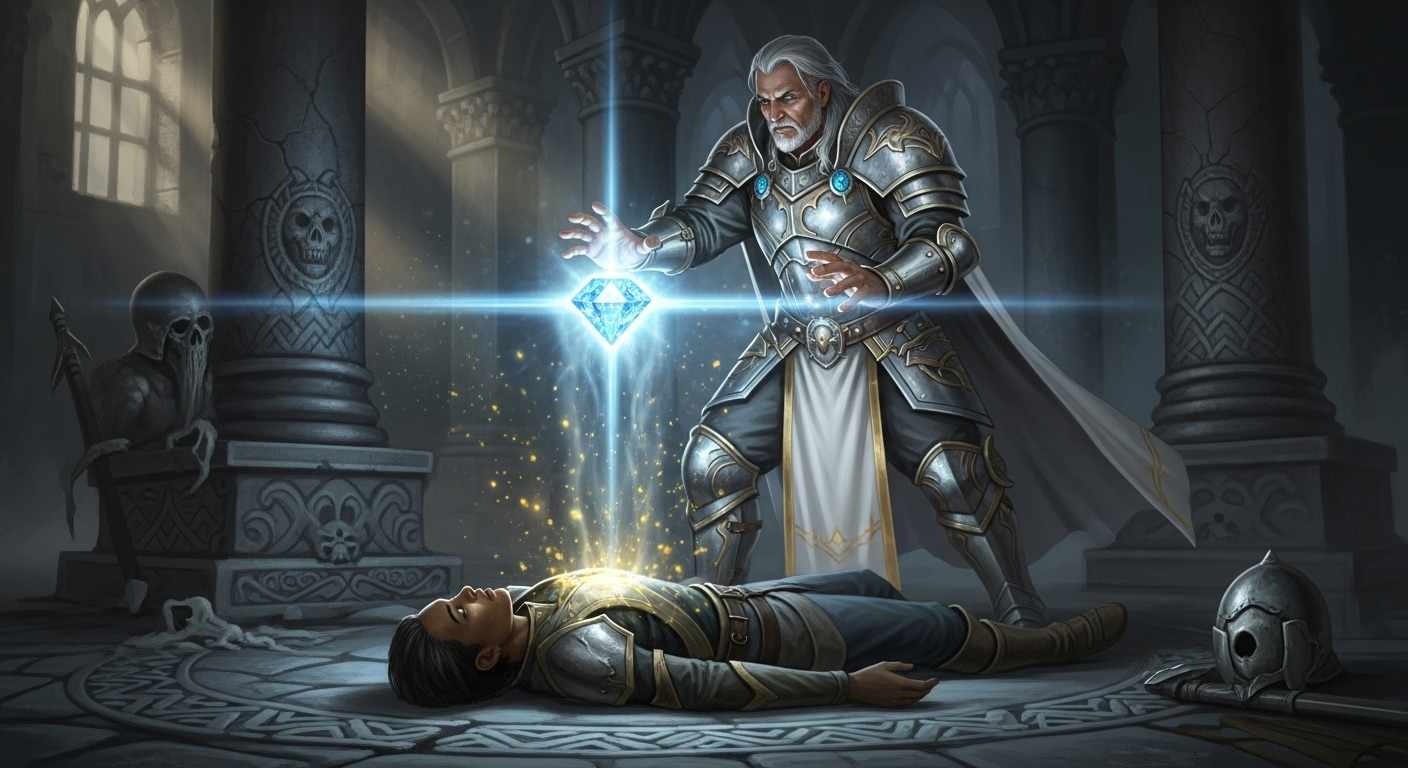Raise Dead

- Level: 5
- School: Necromancy
- Class: Bard, Cleric, Paladin
- Casting Time: 1 hour
- Range: Touch
- Components: V, S, M (a diamond worth 500+ GP, which the spell consumes)
- Duration: Instantaneous
With a touch, you revive a dead creature if it has been dead no longer than 10 days and it wasn't Undead when it died.
The creature returns to life with 1 Hit Point. This spell also neutralizes any poisons that affected the creature at the time of death.
This spell closes all mortal wounds, but it doesn't restore missing body parts. If the creature is lacking body parts or organs integral for its survival—its head, for instance—the spell automatically fails.
Coming back from the dead is an ordeal. The target takes a -4 penalty to D20 Tests. Every time the target finishes a Long Rest, the penalty is reduced by 1 until it becomes 0.
Tactical Usage
Powerful Resurrection Option. Raise Dead provides reliable character revival with extended time window up to 10 days after death, making it the standard mid-level resurrection spell for most parties.
Strategic Revival Planning. The -4 penalty to d20 tests creates meaningful consequences for death while maintaining character viability, requiring tactical consideration of when to resurrect versus when to wait.
Extended Casting Time. The 1-hour casting requirement necessitates secure environments and advance planning, making battlefield resurrection impossible but enabling careful revival procedures.
Spell Combinations
Healing Follow-Up. Combining with healing spells immediately after resurrection helps address the single hit point revival and provides buffer against immediate re-death.
Protection Enhancement. Casting protective spells on recently revived characters helps compensate for the d20 test penalties and provides security during the recovery period.
Safe Environment Creation. Pairing with area protection spells ensures uninterrupted casting during the vulnerable hour-long revival process.
Material Component Details
Significant Diamond Cost. The 500+ gold piece diamond represents substantial investment but provides access to genuine resurrection capabilities for mid-level characters.
Component Consumption. The consumed diamond makes each casting expensive, requiring careful resource management and consideration of resurrection priorities.
Quality Considerations. Higher-value diamonds might provide enhanced resurrection success or reduced revival penalties, though the spell mechanics don't explicitly require superior components.
Creator Notes
Death Consequence Management. Raise Dead provides meaningful resurrection with appropriate consequences, maintaining death stakes while preventing permanent character loss.
Resource Investment Balance. The material cost and casting time prevent casual resurrection while maintaining accessibility for important character revival.
Body Integrity Requirements. The spell's limitations regarding missing essential body parts create interesting tactical considerations about body protection and recovery.
Environmental Interactions
Secure Location Necessity. The hour-long casting time requires defendable positions where interruption risks are minimal during the resurrection process.
Body Preservation Needs. The 10-day time limit creates urgency for character recovery and protection of remains in hostile environments.
Temperature Independence. Unlike lower-level resurrection spells, environmental conditions don't affect the casting success or requirements.
Common Rulings & Clarifications
Time Limit Specificity. The creature must have been dead for no longer than 10 days, providing extended but finite opportunities for resurrection.
Undead Exclusion. Creatures that were undead when they died cannot be resurrected, preventing abuse of undeath states or undead creature revival.
Missing Body Parts. Essential missing parts like heads automatically cause spell failure, while non-essential missing parts might be restored or remain absent.
Penalty Duration. The -4 penalty reduces by 1 after each long rest until eliminated, creating gradual recovery over multiple days.
Alternative Applications
Investigation Opportunities. Reviving victims of crimes, accidents, or mysterious deaths provides access to witness testimony and firsthand accounts.
Diplomatic Revival. Restoring important figures, allies, or negotiation partners can prevent political crises or maintain critical relationships.
Historical Research. Reviving individuals from significant historical events provides unprecedented access to firsthand historical knowledge and perspectives.
Related Spells
Resurrection Magic Progression. Revivify offers faster but more limited revival, while Resurrection and True Resurrection provide more powerful options with different limitations.
Death Prevention. Death Ward and similar spells prevent the need for resurrection, while healing magic addresses damage before death occurs.
Condition Removal. The spell automatically removes poison but doesn't address other conditions that might have contributed to death.
Scaling Analysis
Mid-Level Standard. Raise Dead serves as the primary resurrection option for mid-level characters, providing reliable revival capabilities with appropriate resource costs.
Resource Scaling. The 500 gold cost becomes more manageable as character wealth increases, though it remains significant enough to prevent casual use.
Campaign Integration. The spell becomes increasingly important as character investment deepens and permanent death becomes more impactful to ongoing stories.
Narrative Flavor
Gradual Revival Process. The hour-long casting should emphasize the complex magical process of restoring life, with gradual signs of returning vitality and consciousness.
Death's Toll. The revival penalties and single hit point return should reflect the traumatic nature of death and resurrection, emphasizing the ordeal of returning from beyond.
Divine Intervention. Different casting traditions might manifest unique revival styles reflecting the caster's relationship with death, divinity, or life force manipulation.